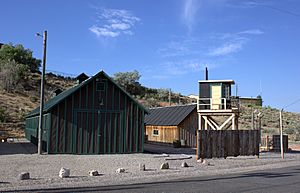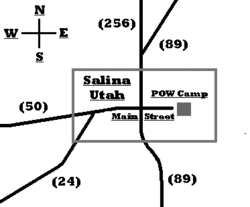Utah prisoner of war massacre facts for kids
Quick facts for kids Utah prisoner of war massacre |
|
|---|---|
| Part of mass shootings in the United States | |

Camp Salina in 2018
|
|
 |
|
| Location | Salina, Sevier County, Utah, United States |
| Coordinates | 38°57′28″N 111°50′52″W / 38.95767°N 111.84777°W |
| Date | July 8, 1945 12:00 midnight (MST) |
| Target | German prisoners of war |
|
Attack type
|
Mass murder, POW massacre |
| Weapons | .30 caliber M1917 Browning machine gun |
| Deaths | 9 |
|
Non-fatal injuries
|
19 |
| Perpetrator | Clarence V. Bertucci |
The Utah prisoner of war massacre happened just after World War II in Europe ended. It took place at midnight on July 8, 1945. This event occurred at a camp for German and Italian prisoners of war in Salina, Utah.
During this event, nine German prisoners were killed. Nineteen other prisoners were also hurt. The person responsible was an American soldier named Private Clarence V. Bertucci. He was on guard duty at the camp. After being out, Bertucci came back to the camp around midnight. He then went to his guard tower. He loaded a powerful machine gun and fired it at the tents where the prisoners were sleeping.
After the shooting, Bertucci said he did it because he "had hated Germans." Six Germans died right away. Two more died in a hospital in Salina, and one died in an army hospital. The nineteen wounded prisoners were sent back to Germany later. Bertucci was taken into custody easily. Doctors later said he was "mentally unbalanced." He was sent to a hospital for treatment. This event is known as the "worst massacre at a POW camp in U.S. history." It was also the largest killing of enemy prisoners in the United States during World War II. A museum about Camp Salina opened in 2016.
Contents
Camp Salina: A Look Back
During World War II, about 15,000 Italian and German prisoners were held in camps across Utah. Camp Salina was a smaller camp. It helped hold extra prisoners from a larger camp in Salt Lake City. From 1944 to 1945, about 250 German prisoners stayed there. Most of them were from the Afrika Korps, a German army group.
The camp was simple. It had 43 tents with wooden floors, a building for officers, and three guard towers. Before it was a prison camp, it was a Civilian Conservation Corps facility. Unlike many other camps, Camp Salina was inside the small town of Salina. The German prisoners worked there to help harvest sugar beets and other crops. People in the town said the prisoners were well-behaved and friendly.
The Soldier: Clarence V. Bertucci
Soldiers who were not sent to the front lines often guarded these camps. Private Clarence V. Bertucci was one of them. He was born in New Orleans in 1921. He left school after the sixth grade. He joined the United States Army in 1940.
Bertucci had served for five years. He had even been to England with an artillery unit. However, he had not been promoted and had some problems following rules. He had also said that he felt "cheated" because he had not had a chance to fight Germans. He was quoted saying, "Someday I will get my Germans." Even though he often said he hated Germans, he did not show any signs of what he was planning before the massacre. He was 23 years old when the shooting happened.
The Midnight Massacre
On the night of July 7, 1945, Bertucci was out before his guard shift. He stopped at a cafe and spoke with a waitress. He told her "something exciting is going to happen tonight." Then, he went back to the camp for his guard duty.
After the guards changed at midnight, Bertucci waited for the previous guard to leave. He then climbed into the guard tower closest to the officers' area. He loaded the .30-caliber M1917 Browning machine gun that was in the tower. Then, he started firing at the tents where the German prisoners were sleeping. Bertucci moved the gun back and forth. He hit 30 of the 43 tents. Another soldier then removed him from the tower. Bertucci reportedly said, "Get more ammo! I'm not done yet!"
The shooting lasted about fifteen seconds. During this time, about 250 rounds of ammunition were fired. Lieutenant Albert I. Cornell told Bertucci to come down from the tower. Bertucci refused, saying, "some of them [Germans] are still alive." Another guard was sent to bring him down. Bertucci was taken into custody without fighting. Guards watched closely for any reaction from the prisoners, but there was none.
Six German prisoners died right away. Two more died later in Salina's hospital. One died in an army hospital. Nineteen others were wounded. There was not enough room in the hospital. Many wounded prisoners were treated on the hospital lawn.
The prisoners who died were:
- Otto Bross (age 25)
- Ernst Fuchs (age 24)
- Gottfried Gaag (age 29)
- Georg Liske (age 31)
- Hans Meyer (age 24)
- Adolf Paul (age 28)
- Fritz Stockmann (age 24)
- Walter Vogel
- Friedrich Ritter (age 48), who died five days later from his injuries.
Newspapers reported on the event. The Piqua Daily Call wrote that Bertucci was under observation. He had admitted to shooting the prisoners because he "just didn't like Germans." An article from the Chillicothe Constitution-Tribune said Bertucci showed no regret after the shooting. Time magazine also reported on the event. They noted that Bertucci's military record showed he had been punished before. Bertucci's mother said she believed his actions were due to a medical procedure he had five years earlier. She told the New York Times that "something must have happened to him."
What Happened Next
After the attack, Bertucci was held at Fort Douglas. His army record showed he had been punished three times before. He had also been hospitalized 12 times, some for mental evaluations. Army officers first said the attack was due to mental illness. Captain Wayne Owens was asked to investigate. He thought Bertucci was mentally sound and should face a military trial. However, Owens's superiors said he could not decide on Bertucci's mental state. Owens changed his report but still suggested a trial. He believed Bertucci's actions were planned.
Major Stanley L. Richter of the Prisoner of War Operations office also thought a trial might happen. However, Bertucci was evaluated for several weeks at Bushnell Army Hospital in Brigham City, Utah. Doctors decided he was "mentally unbalanced." A group of military officials agreed he was mentally unwell. Instead of a trial, Bertucci was sent to Mason General Hospital in Brentwood, New York. He stayed there for some time. He passed away on December 2, 1969.
The nine victims were buried with full military honors at Fort Douglas Cemetery on July 12. They wore American uniforms. There were no flags on their coffins because the Flag of Nazi Germany was banned. There was no new German flag available. Each coffin had two wreaths of flowers. Fifteen prisoners from Salina attended the service. A choir sang songs, but no Nazi songs were allowed. A second service was held for Friedrich Ritter, who died later.
It took a long time to tell the families of the dead prisoners. It was also hard for families to get money for their loss. The wounded soldiers were sent back to Germany when they were healthy enough. A deal between Germany and the U.S. government meant wounded prisoners could not get American money for their injuries. They only received the same benefits as German veterans.
A statue called the German War Memorial is at the cemetery. In 1988, the German Air Force paid to fix the statue. A ceremony was held on Volkstrauertag, Germany's national day of mourning. Two of the prisoners who were wounded in 1945 came to this ceremony.
On November 12, 2016, a museum opened at the site of Camp Salina. The Utah prisoner of war massacre is known as the largest killing of enemy prisoners in the United States during World War II.
Images for kids



